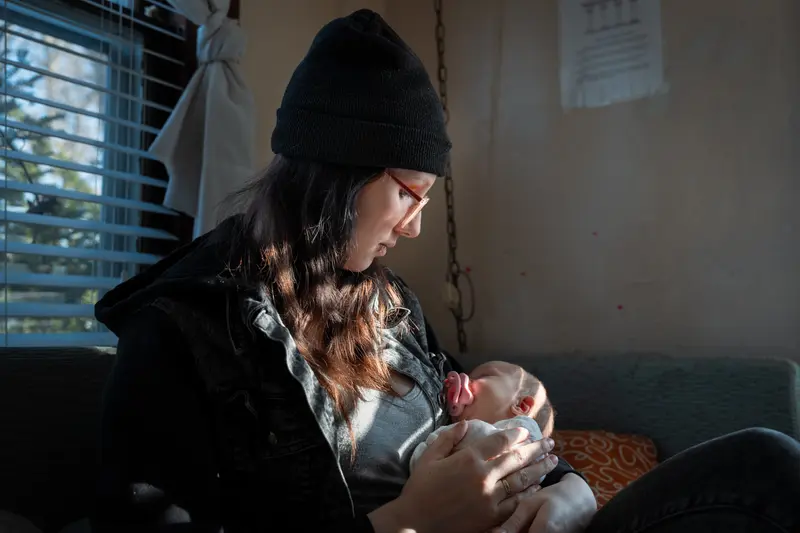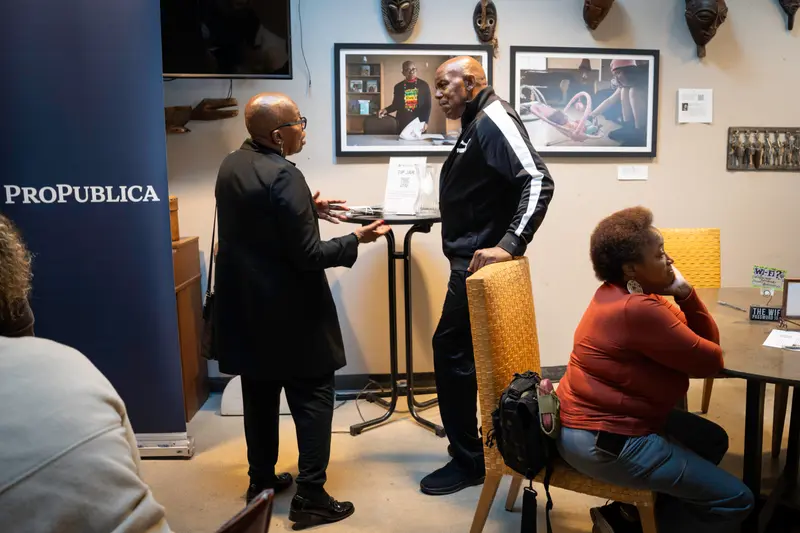Last month, reporter Anna Clark and I hosted an in-person photo gallery and group discussion about what motivated us to tell stories of Flint, Michigan, residents 10 years after the start of the water crisis and to talk about how we work to understand the communities we serve. As a visual fellow at ProPublica, I’m focused on documenting the lives of people in our stories through photography. Throughout history, photography has been a powerful tool for recording moments in time, providing visual evidence and evoking emotions that urge us to understand experiences outside of our own. Here are suggestions for aspiring visual storytellers who may find themselves in similar situations.
Ask “Why Does This Story Need to be Told?”
Anna and I previously worked in Flint in different capacities: I interned as a photojournalist at the Flint Journal; Anna wrote a book, “The Poisoned City: Flint’s Water and the American Urban Tragedy.” To us, Flint is not just a news story, it’s a complex place full of real people who have been and continue to be denied adequate resources and support. We wanted the public to know that generations of Flint residents still live with physical and psychological challenges. By sharing what Flint residents think accountability would look like, we were able to show how many feel betrayed by the failure to hold anyone criminally responsible. They also remain frustrated by how long it’s taking to fix the local water system and the lingering mental wounds that may never be repaired.
The photo essay gave a glimpse into the experience of three residents and how their present-day concerns, fears and decisions are shaped by the water crisis. Over about four months, I made frequent visits to Flint — stopping by nonprofits, churches, after-school programs and other places that are part of everyday life. I spoke with incredibly kind people. Some wanted to help me; others were hesitant, usually because they wanted to move on or felt things would never change. Robert McCathern, Teagan Medlin and Jacquinne Reynolds granted me a great deal of trust. They were able to open up and make themselves vulnerable because of their commitment to cultivating change for future generations. I tried to represent that through the environment in the photographs.


Be Sincere With Your Approach
During the discussion at the visual storytelling event at Totem Books in Flint, we asked residents to ponder what type of stories resonate with them most, what questions they wish someone would ask them and who is one person they would like to interview. We discovered a common thread of wanting to feel more connected as neighbors and fellow human beings.
Then we flipped the exercise to challenge ourselves as journalists and receive questions from residents. “Why Flint?” one participant asked us. We told her how we’d come to admire the community and wanted to present a multidimensional view of it to readers. “Something about this place seems to get in people’s blood,” the participant told us, and it does seem that for a city of its size, Flint has attracted a disproportionate number of storytellers — even before the water crisis. And yet, some residents still wonder: What has changed? Over the past decade, Flint residents have been in the public eye not by choice, but as a result of a disaster created and prolonged by public officials. So what does that mean for us and our responsibility as storytellers?
Being in the business of transparency requires us to also be transparent with the communities we document. Without transparency, it’s hard to build mutual trust, especially in communities that have faced betrayal and have had little control over how their stories are shared with the world.
During the early stages of the project, before lifting my camera to make any photos, I listened to Flint residents and learned about their stories, then let what they told me naturally guide the photos I made. Early on, I also stressed that I believe their stories are important to share because people outside of Flint should know that for many Flint residents, the crisis is still not over.
I also should note that our stories go through many layers of revisions and fact-checking. From beginning to end, I tried to communicate how the project was developing and made sure that our sources were aware of how the story would be framed, how they would be portrayed and how they would be quoted. Once the story was published, I followed up to gauge how they were feeling, and later made them aware that photographs of them would appear at our galley in Flint.

Credit:
Rocio Ortega/ProPublica
Look for Connection and Insight
The beauty of visual storytelling is that the story can always change shape. Let go of any assumptions and let the story lead you where it may. Anna and I learned so much by taking this approach.
We found that, after a decade, many residents are still waiting for the change they want to see. The flood of the resources and attention Flint initially received has dwindled. But one of the reasons I wanted to revisit this story is because of the people I’ve met and will continue to meet. The city has introduced me to people who care deeply about their community and embrace one another with generosity, care and compassion. And I learned about a host of local programs, from the Flint Rx Kids program that provides financial support for mothers to the McKenzie Patrice Croom Flint Community Water Lab, which trains youth to give back and provides free water testing. Although communities like Flint shouldn’t need to be resilient, we can learn from their empathy, advocacy and support for one another during hard times. My job is to make photographs, but a big part of the fulfillment I get is from making connections.
We closed out our event in Flint by making photographs of attendees that they could have as keepsakes. One woman, who told me she had recently been displaced from her home, said she was going to email the photos of herself to her grandchildren who live in another state. It reminded me that photographs are invaluable in many facets of our lives. They keep us connected.

